Weekly Arizona COVID-19 Data Report – Dr. Joe Gerald, August 27
Note this forecast page is not the most recent forecast available.
View the most current forecast report
Researcher Analyzes Arizona COVID-19 Spread Models for Decision-Makers
The following information regarding the spread of COVID-19 in Arizona was prepared by Joe Gerald, MD, PhD, a researcher at the Mel and Enid Zuckerman College of Public Health (MEZCOPH) at the University of Arizona. This information has also been reviewed by other MEZCOPH faculty.
This data were obtained from the Arizona Department of Health Services COVID-19 webpage and reflect conditions in Arizona as of August 27, 2021.
This information is intended to help guide our response to the outbreak. It is not intended to predict how this pandemic will evolve. Rather, this model extrapolates what might occur if current conditions remain unchanged. As regional authorities and healthcare providers respond, their actions are expected to mitigate the worst consequences of this pandemic.

COVID-19 Disease Outbreak Forecast
Arizona State and Pima County
Updated August 27, 2021
Disclaimer: This information represents my personal views and not those of The University of Arizona, the Zuckerman College of Public Health, or any other government entity. Any opinions, forecasts, or recommendations should be considered in conjunction with other corroborating and conflicting data. Updates can be accessed at https://publichealth.arizona.edu/news/2021/covid-19-forecast-model.
For the week ending August 22nd, 21086 Arizonans were diagnosed with COVID-19, a 4% increase from last week’s initial tally of 20260 cases (Figure 1). This marks the 11th week of increasing case counts but the second of only modest week-to-week increases. The current rate, 299 cases per 100K residents per week, is increasing by 13 cases per 100K residents per week. Case rates are highest among those 15 – 24 years and lowest among those >65 years, 379 versus 136 cases per 100K residents per week, respectively (Figure 2a). At 362 cases per 100K residents, rates among those 15 years have almost surpassed those of adolescents and young adults.
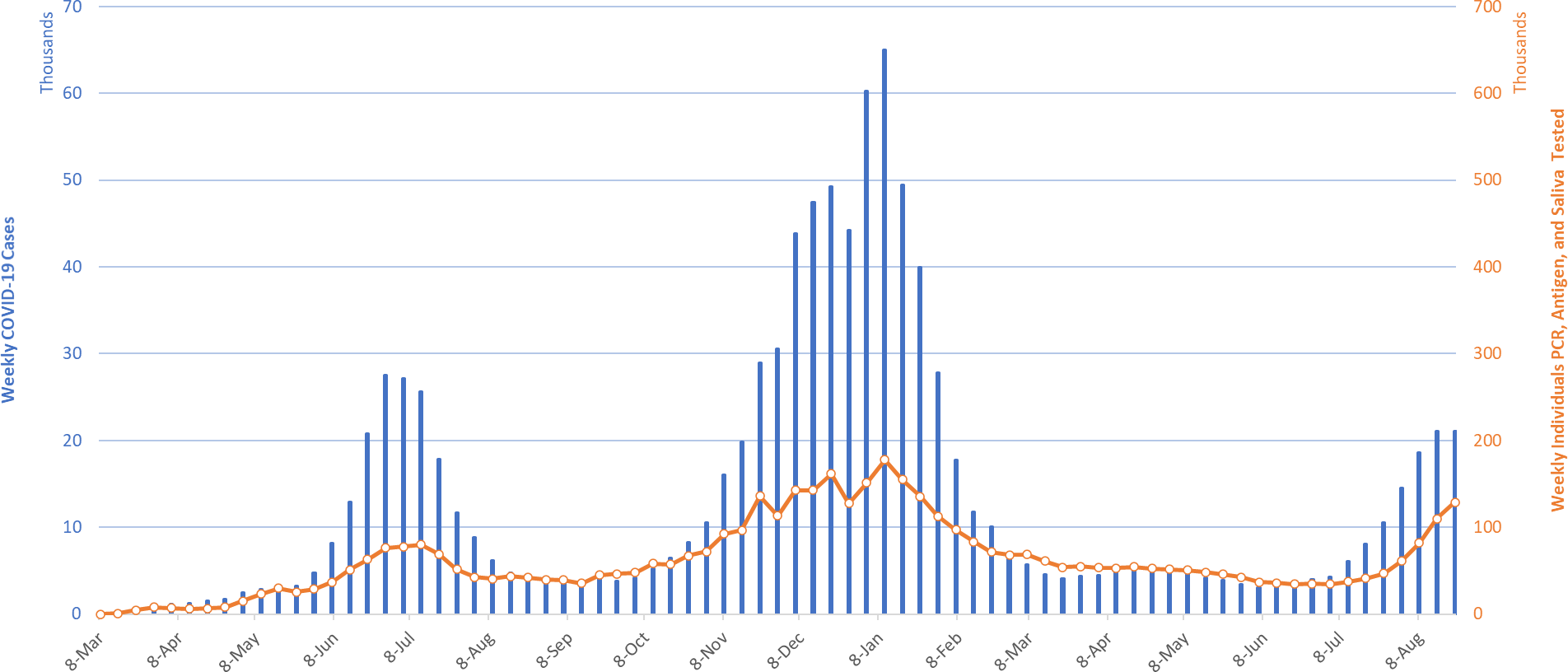
|
Figure 1. Weekly COVID-19 Cases in Arizona and Number of Individuals Undergoing COVID-19 Diagnostic Testing March 1, 2020 – August 22, 2021. |
While Arizona continues to experience a high number of cases, hospitalizations, and deaths, week-to-week increases are currently moderating. Because behavioral dynamics are an important driver of community transmission, this recent moderation could be temporary. Arizona’s case rates remain below those observed during the July 2020 peak, 409 cases per 100K residents per week. Arizona’s national ranking has fallen to 27th out of 50 states this week. Mississippi (753), Louisiana (705), and Florida (691) continue to lead the pack with Kentucky (599) and South Carolina (574) being new entrants. While rates are moderating in Mississippi and Louisiana, they are increasing in the remaining 3 states.
According to the CDC, 58% of Arizona’s adult population is fully vaccinated and another 10% have received one dose. The ADHS Vaccine Dashboard shows weekly doses delivered are somewhat higher than previously reported, about 100K per week, and are now slowly increasing rather than declining. Faster would be better but this is still encouraging. Even though vaccination remains the most effective and important mitigation strategy, non-pharmacologic interventions like mask mandates, limited gathering sizes, and targeted business mitigations are still needed to slow transmission and ensure this wave does not reignite.
Figure 2a shows that transmission among children (dotted) is poised to surpass rates among all other groups for the first time during the pandemic. Resumption of K-12 in-person instruction in the face of high community transmission, inadequate vaccination, prohibited masking, and inadequate surveillance testing is undoubtedly the cause.
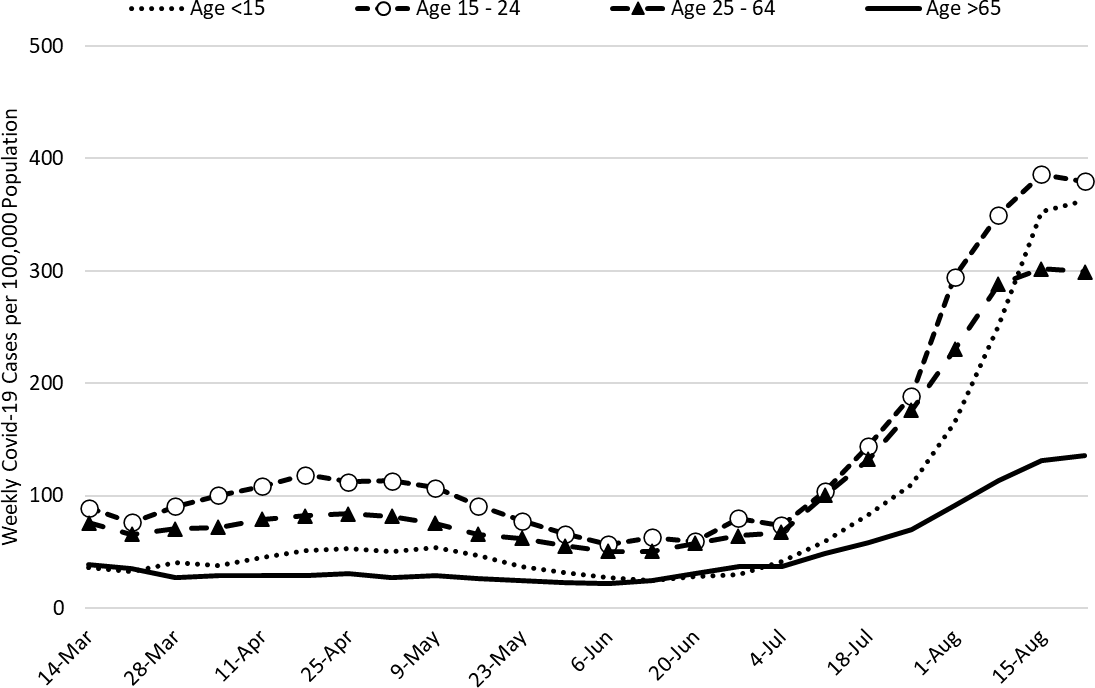
|
Figure 2a. COVID-19 Cases in Arizona by Age Group March 7, 2020 – August 22, 2021. |
This is underscored by higher case rates among those 10 – 14 years as compared to those 15 – 19 years (Figure 2b). This reversal may be short-lived as universities resumed operations last week. Therefore, transmission among those 15 – 19 years is expected to increase in the coming weeks (https://www.nature.com/articles/s41467-021-25169-3).
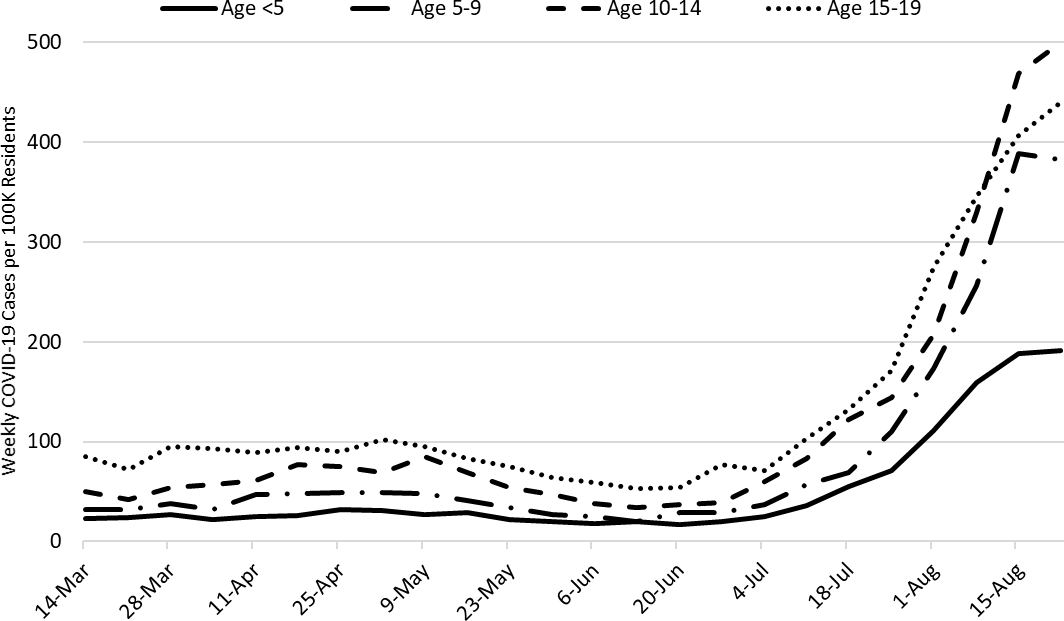
|
Figure 2b. COVID-19 Cases in Arizona among Children by Age Group March 7, 2020 – August 22, 2021. |
To create a mental frame, it is helpful to compare our current circumstances to those previously experienced. Comparing school reopening this year (in-person) with last year (virtual), levels of community transmission are much higher this year, particularly among those 15 years (Figure 2c). For those with inquiring minds, accelerated transmission among those 15 – 24 years attributable to last year’s university re-openings was not observed until August 30, 2020.
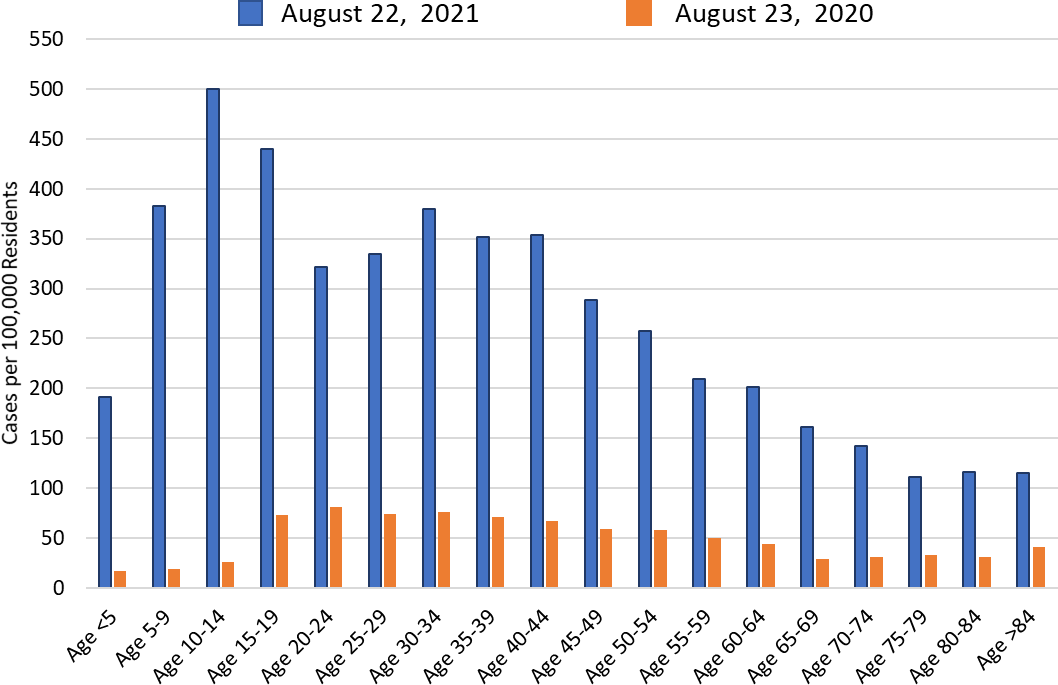
|
Figure 2c. COVID-19 Cases in Arizona by Age Group August 23, 2020 versus August 22, 2021. |
The past two weeks have marked a divergence between the trajectory of the current outbreak and that of the winter 2020/2021 outbreak (Figure 2d). However, there have been temporary retreats before, so it is important to wait several more weeks before signaling a more permanent shift, especially in light of university re-openings.
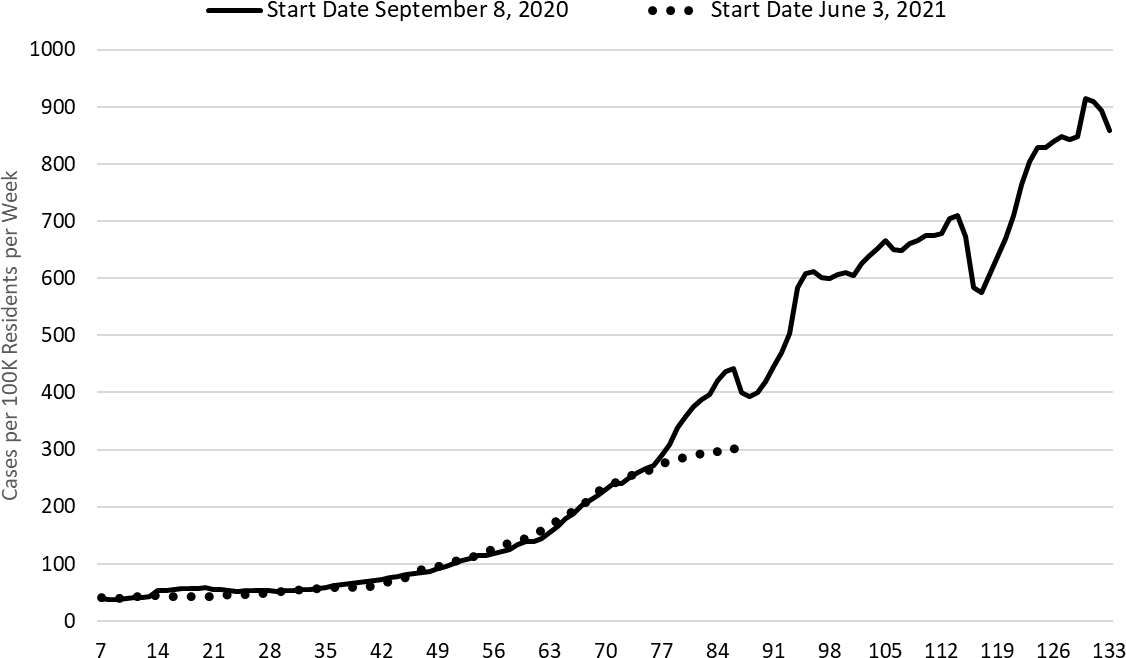
|
Figure 2d. Fall 2020 and Fall 2021 COVID-19 Waves Superimposed (88 days). |
Test positivity among those undergoing traditional nasopharyngeal testing dropped this week to 19% (Figure 3). This level of positivity indicates that testing is inadequate for optimal public health practice and that many cases are going undiagnosed. Prior peaks in test positivity have preceded peak transmission rates by 1 week. This provides additional support that the current slowing represents a sustained change.
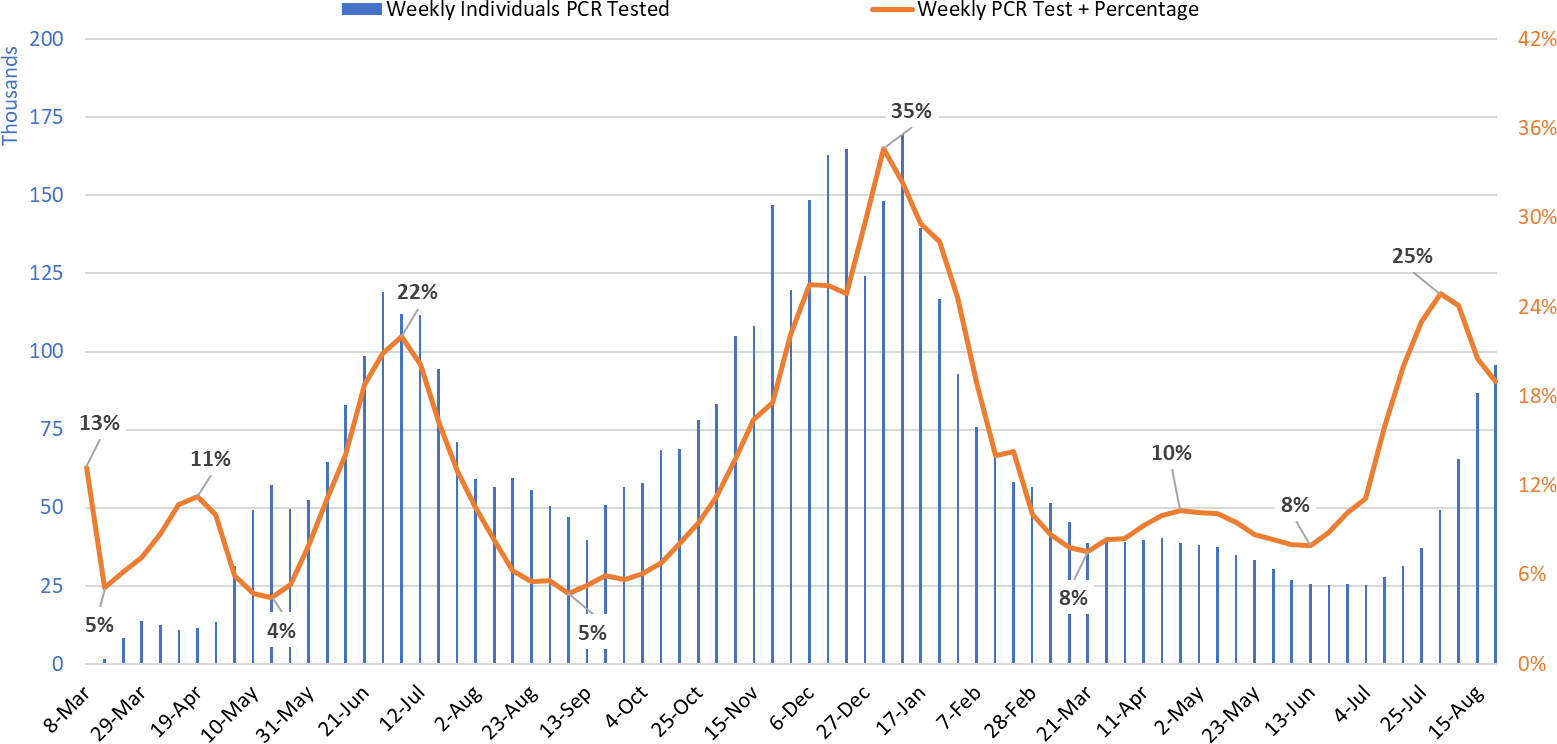
|
Figure 3. Weekly Number of Patients Undergoing Traditional Nasopharyngeal PCR Testing and Associated Percent Positivity March 1, 2020 – August 22, 2021 |
As of August 25th, 1978 (23%) of Arizona’s 8791 general ward beds were occupied by COVID-19 patients, an 8% increase from last week’s 1837 occupied beds (Figure 4 and Figure 5 Panel A). Another 730 (8%) beds remained available for use. The number of available beds is somewhat higher than last week’s 717 beds.
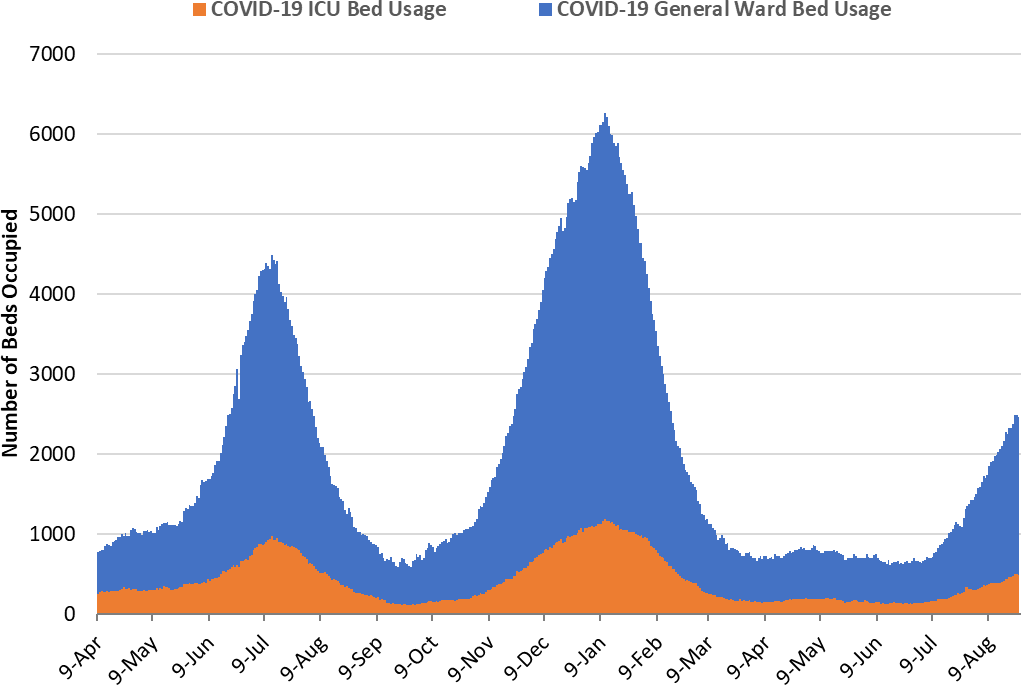
|
Figure 4. Arizona Daily COVID-19 General Ward and ICU Census April 9, 2020 – August 25, 2021. |
As of August 25th, 487 (28%) of Arizona’s 1765 ICU beds were occupied by COVID-19 patients, a 13% increase from last week’s 432 occupied beds (Figure 4 and Figure 5 Panel B). An additional 141 (8%) ICU beds remained available for use, meaningfully lower than last week’s 189 beds.
|
Figure 5. COVID-19 Occupancy as a Percent of Listed General Ward (A, left) and ICU (B, right) Capacity in Arizona April 20, 2020 – August 25, 2021. |
Arizona hospital occupancy remains above seasonal levels and safety margins as measured by excess, available beds continues to erode (Figure 6). Undoubtedly, some medically necessary procedures are being postponed to make room for critically ill COVID-19 patients. Although increases in occupancy should moderate in the next week or so in response to moderated community transmission, hospitals should be prepared for >20% ward occupancy and >25% ICU occupancy for several more weeks. Even if you are vaccinated, the COVID-19 surge can impact your access to healthcare services should you become ill and require hospital care.
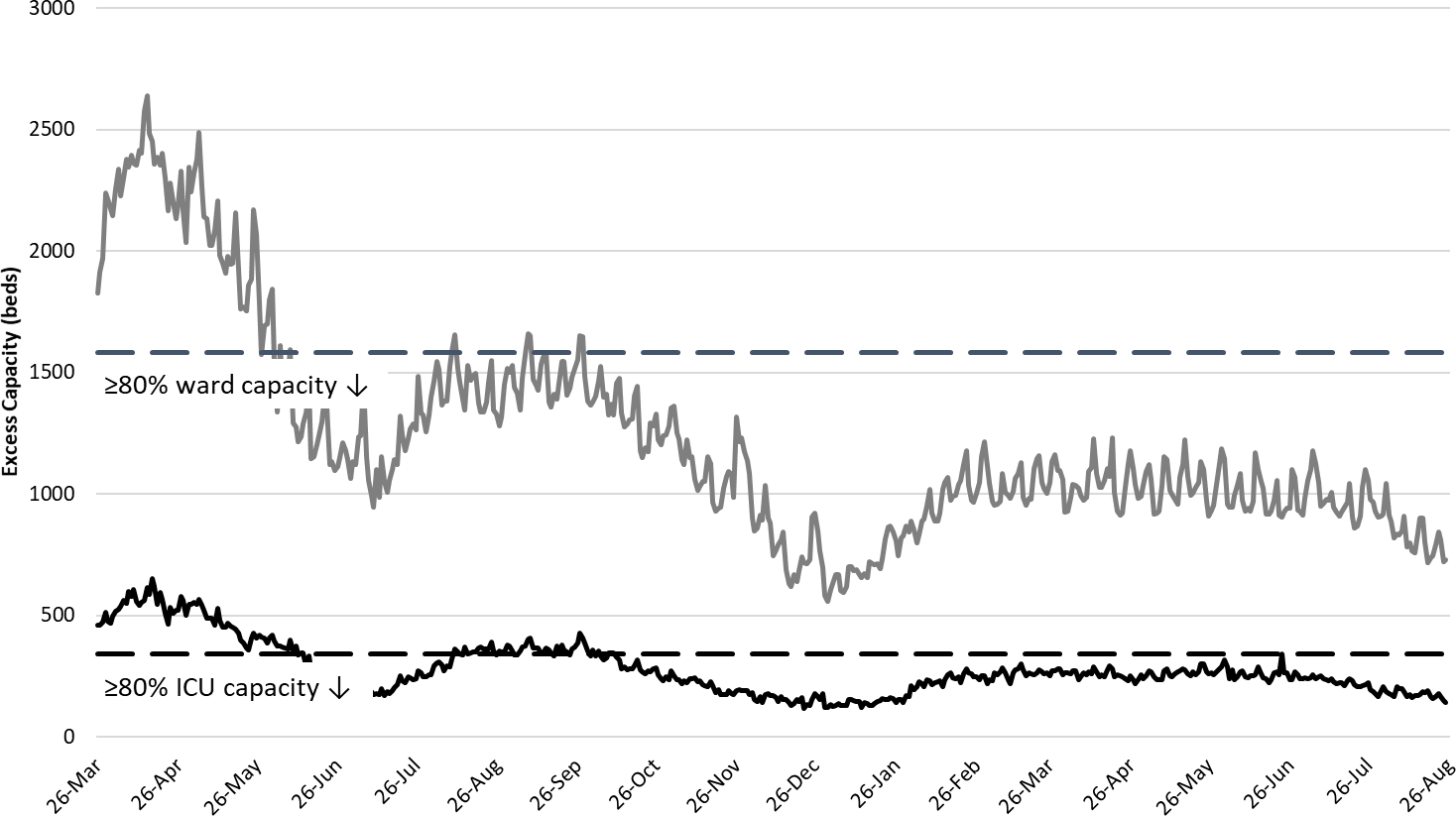
|
Figure 6. Observed Excess Non-Surge General Ward and ICU Capacity in Arizona March 26, 2020 – August 25, 2021. |
Arizona is experiencing >100 COVID-19 deaths per week (Figure 7). The week ending August 1st has recorded 135 deaths so far with the weeks ending August 8th and 15th close behind, 114 and 112 deaths, respectively. So far, the rise in the number of deaths seems to be more muted than expected given the rapid rise in cases. While it is too early to know if there is going to be a readjustment to the historical case fatality rate, about 1.5%, it is something worth continued observation.
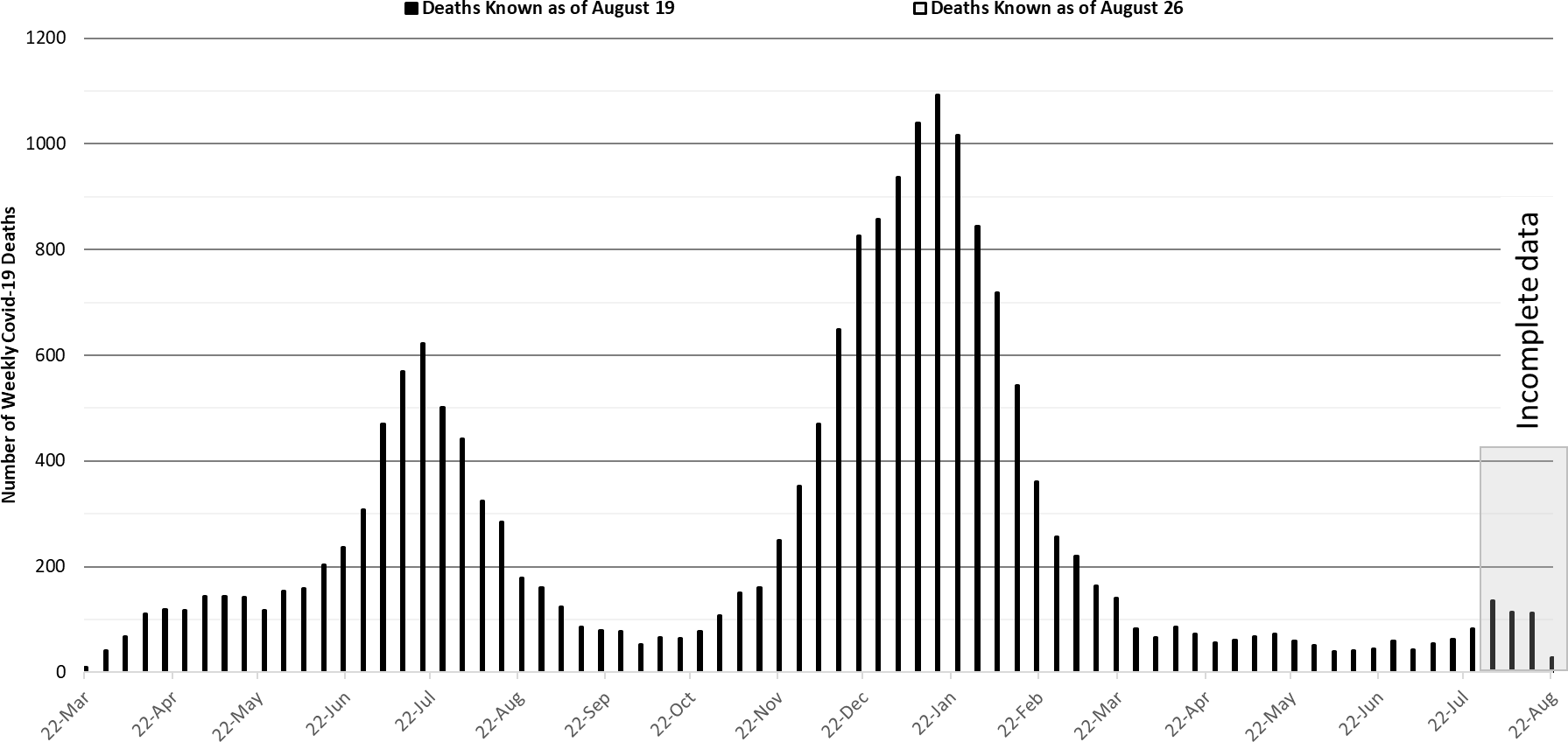
|
Figure 7. Weekly Arizona COVID-19 Deaths March 16, 2020 – August 22, 2021. |
Pima County Outlook
For the week ending August 22nd, 1870 Pima County residents were diagnosed with COVID-19 (Figure 8). This is a 4% increase from the 1804 cases initially reported last week.
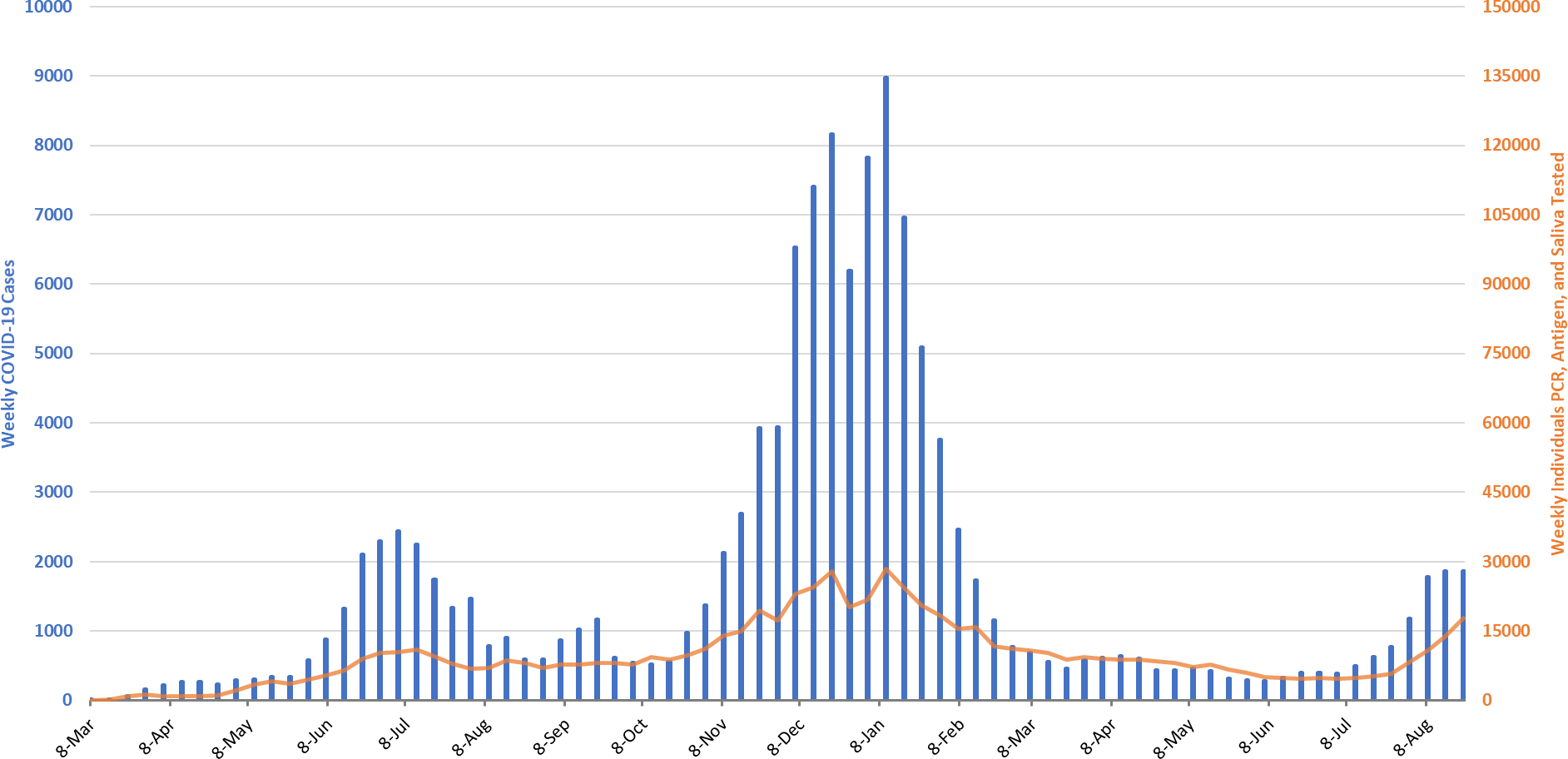
|
Figure 8. Weekly COVID-19 Cases in Pima County and Number of Individuals Undergoing COVID-19 Diagnostic Testing March 1, 2020 – August 22, 2021. |
New cases are being diagnosed at a rate of 188 cases per 100K residents per week. This rate is increasing by 14 cases per 100K residents per week. Trends across the various age groups appear in Figure 9.
Note: Cases among those >65 years continue to rise which will continue to put upward pressure on hospitalizations.
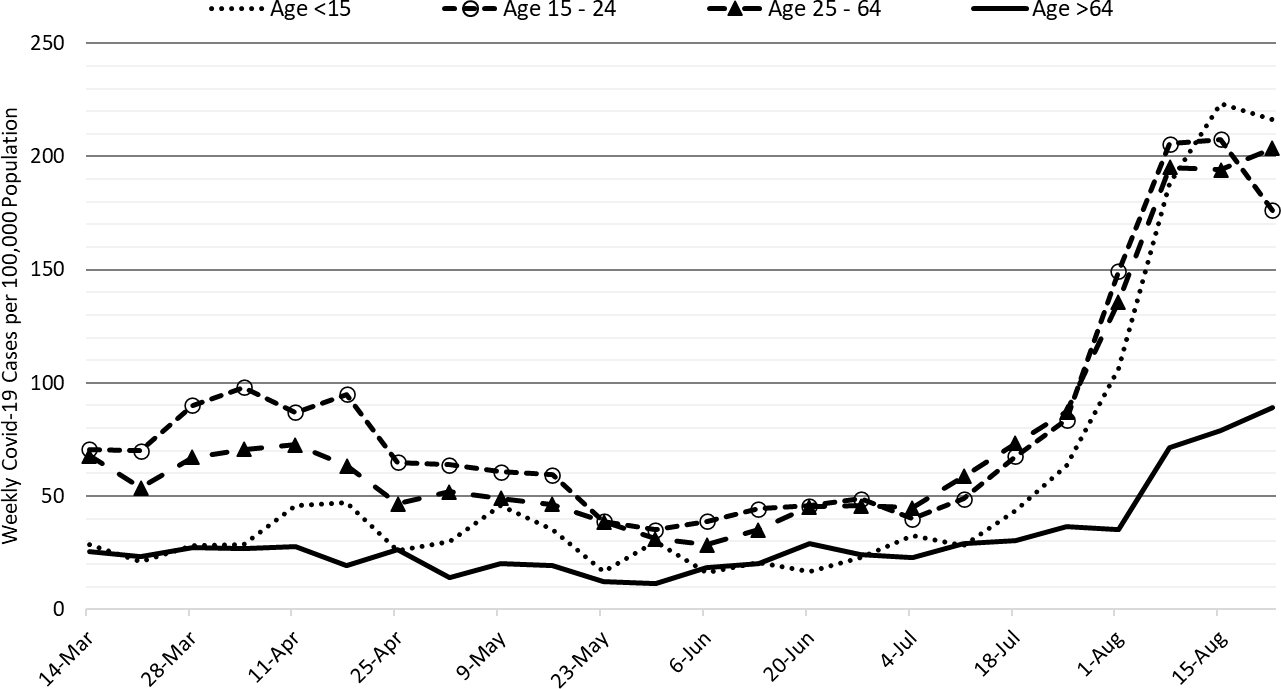
|
Figure 9. COVID-19 Cases in Pima County by Age Group March 7, 2020 – August 22, 2021. |
Summary
- Arizona continues to experience high levels of community transmission. Increases in transmission have moderated over the past 2 weeks; however, temporary “pauses” have been observed in previous waves. With continued K – 12 in-person instruction along with re-opening of our major universities, there will be continued upward pressure on community transmission among children and young adults. If transmission in these groups spillover, then another resurgence from our current plateau remains possible (https://jamanetwork.com/journals/jamapediatrics/fullarticle/2783022) .
- As of August 22nd, new cases were being diagnosed at a rate of 299 cases per 100K residents per week. The rate was increasing by 13 cases per 100K residents per week.
- The age distribution of transmission has undergone a profound change since resumption of K – 12 instruction. For the first time during the pandemic, case rates among children are among the highest of any age group. Undoubtedly, the combination of Delta, poor mask compliance, and in- person instruction is driving this transition.
- Vaccination remains the most important public health priority to reduce viral transmission and severe illness in the long run; however, mask mandates, restrictions on indoor gatherings, and targeted business mitigations are needed to reduce transmission in the short-term. Masking works people (https://science.sciencemag.org/content/372/6549/1439)!
- Resumption of in-person instruction in K -12 schools and universities will lead to frequent school- associated outbreaks and contribute to community transmission. A layered approach with multiple non-pharmacologic interventions is necessary to return students safely to the classroom (https://science.sciencemag.org/content/372/6546/1092).
- Hospital COVID-19 occupancy is increasing and is likely to exceed 20% of all beds in the general ward and 25% of beds in the ICU for weeks to come. Access to care is becoming more restricted as COVID- 19 occupancy is increasing. Expect delays in elective procedures to mount once again.
- Arizona is experiencing >100 COVID-19 deaths per week. This amount will continue to increase in the coming weeks as more deaths occur and are recorded. Although looking less likely, weekly totals in excess of 300 deaths remain possible for the end of August – early September once all deaths are tabulated.
- According to the CDC, 58% of Arizona adults have received at least 2 doses of vaccine while another 10% have received 1-dose. In the face of the Delta variant, this is insufficient to prevent continued community transmission.
- Despite evidence of limited immune escape, especially before completion of the full vaccination sequence, vaccination continues to provide high levels of protection from severe illness (https://www.cdc.gov/mmwr/volumes/70/wr/mm7032e3.htm).
- Dr. Deepta Bhattacharya discussed what we know so far about COVID-19 vaccines, the interactions between the vaccines and the latest variants, and the best strategies for staying healthy (https://provost.arizona.edu/content/campus-webinars).
- The CDC mask guidance for vaccinated individuals (https://www.cdc.gov/coronavirus/2019- ncov/vaccines/fully-vaccinated-guidance.html) and for K -12 instruction (https://www.cdc.gov/coronavirus/2019-ncov/community/schools-childcare/k-12-guidance.html) continue to recommend masking when indoors in public spaces where community transmission is high or substantial. If in close contact with a known case, vaccinated individuals should be tested in 3 – 5 days regardless of symptoms and wear a mask for 14 days post-exposure or until a negative test result.
Forecast reports to date, available as PDFs
Download PDF to view additional charts of Arizona counties, available in appendix of report.
2020 Reports
Based on what we know now about this pandemic, we support guidelines for social distancing to slow the spread of the virus and urge everyone to follow the recommendations provided by the Centers for Disease Control and Prevention (CDC) to protect yourself, your family, your neighbors, and your employees. Please heed the recommendations as provided by the CDC.
COVID covid coronavirus virus covid19 corona forecast model

